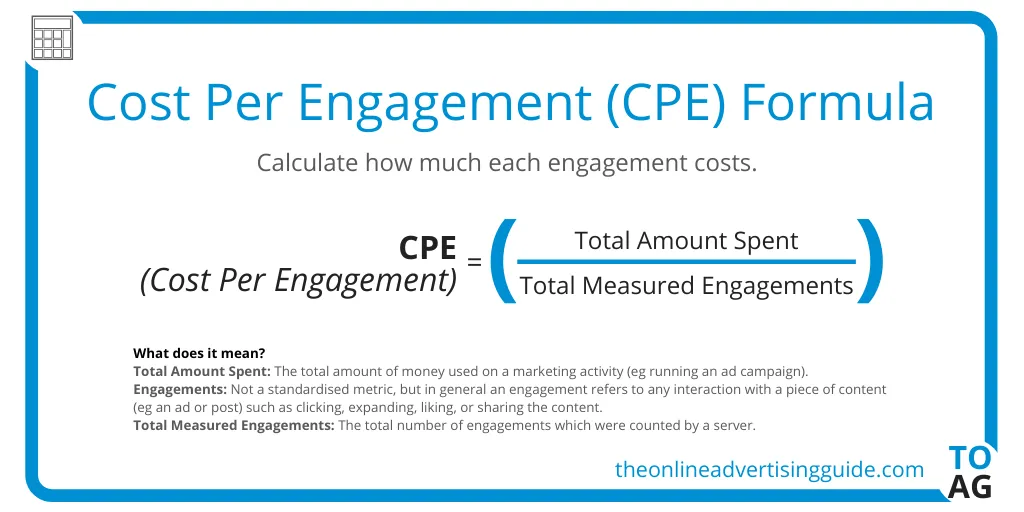Cost per engagement Calculator
A Useful Metric To Measure Engagement Of Every Individual Social Media Campaign!
- 1
Performance-Based Pricing
Cost Per Engagement campaigns ensures that advertisers do not waste money on ads that never reach their target audiences. Before being charged, new users must interact with their app; if they install and do not engage, the advertiser is not required to pay. Because each user is more than an installer, advertisers are protected from certain types of mobile ad fraud, such as organic poaching.
- 2
Promotes User Choice
The app market is extremely crowded, and quality users are becoming increasingly difficult to come by. Users self-select and engage only with offers that interest them when they engage in rewarded in-app engagements.
- 3
Guaranteed Ad Engagement
Placing ads for your gaming app in front of users who enjoy mobile games emphasizes the value of your app right away, increasing the likelihood of long-term retention.
What Does CPE Mean?
Digital marketing agencies and advertisers who utilize the cost-per-engagement pricing model only pay for ads when consumers engage with their campaigns in some way.
Any interaction a user has with an advertisement, such as pausing or muting a video, playing a minigame, filling out a survey, signing up for a free trial, leaving a product review, or sharing an interactive post on social media, is referred to as engagement. Advertisers can select a model that charges for every interaction, such as merely closing the ad, or for meaningful interactions, such as visiting the website and interacting favorably with the ad.
How Is Cost Per Engagement Calculated?

The CPE metric uses the cost-per-engagement calculator to get the end results. The formula used by the CPE calculator is the total cost spent divided by the total noted engagements.
The formula used to calculate CPE is
CPE = total cost spent / total measured engagements
In this metric, the “total cost spent” is actually the amount of money used to create ads and get engagements. While “total measured engagement” refers to the sum of interactions generated by the advertisement.
Benefits Of Cost Per Engagement Advertising
-
-
- Improve Flexibility And Creativity
The cost-per-engagement ad helps advertisers become more aware of market trends, which boosts the creation of creative work. - Engagement is a general term.
Advertising firms can define engagement in their own terms because the phrase has so many different meanings, which makes it simpler to adjust to shifting advertising platforms and trends. - Increased engagement
Every interaction—whether a customer makes a purchase on the company’s website, signs up for a service, or downloads an app—increases brand recognition and the likelihood of achieving the campaign’s final goal. - Improved budgeting
CPE marketing ensures that marketing departments don’t blow their entire money on pointless advertisements. Businesses will only pay for advertisements that have resulted in some type of verified, significant interaction. If consumers don’t interact, advertisers won’t be charged, and their budget is kept intact.
Why Does Cost Per Engagement Matter?
The first thing you should know about CPE statistics is that, generally, the cost of CPE equals your entire advertising expenditures divided by the total number of interactions with those expenditures. But what does this actually imply for you?
Let’s say you spend a whopping $10,000 on targeted adverts to increase traffic to your website. A total of 1,000 separate engagements result from all of that advertising power. It’s possible that some of these interactions were meaningful or not (a user paused or muted your video, for example).
Whatever the situation may be, the result of 10,000 divided by 1,000 is 10. This implies that each engagement with your ads will be valued at $10. What does this mean to you and your company, though?
How do you determine whether the money you spend on advertising is actually worthwhile? You should first be aware that you won’t always have to spend $10,000 on ads to drive visitors to your website. You might choose to spend significantly more or substantially less than that amount, depending on what you want your advertising campaign to achieve.
- Improve Flexibility And Creativity
-
